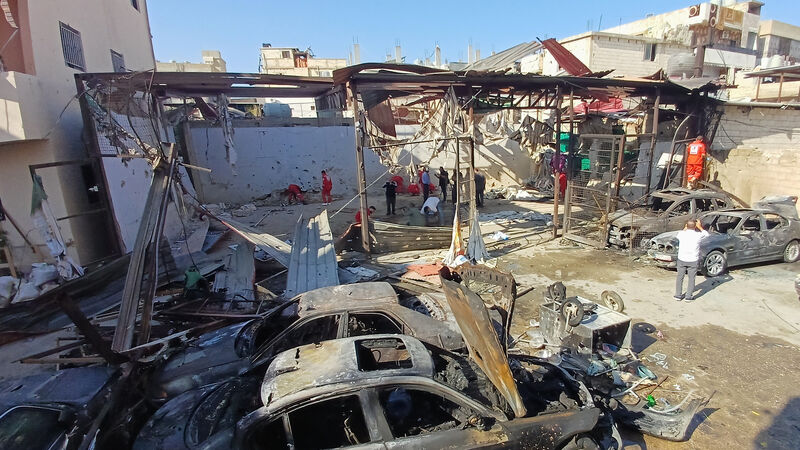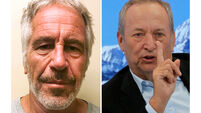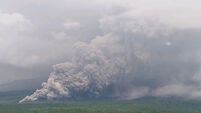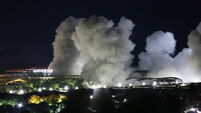Israel’s military carries out strikes in Lebanon and Gaza, killing dozens

The Israeli military has carried out multiple barrages of airstrikes in southern Lebanon on what it said were Hezbollah weapons storage facilities after a drone strike earlier in the day killed one person and wounded several others, including students on a bus.
The new wave of strikes came as tensions between Israel and militants are escalating.
An airstrike on Tuesday night killed 13 people in the Palestinian refugee camp of Ein el-Hilweh, the deadliest of Israeli attacks since a ceasefire in the Israel-Hezbollah war a year ago.
Meanwhile, hospitals in Gaza said Israeli strikes had killed at least 25 Palestinians.

The Israeli military warned on Wednesday afternoon it would strike targets in several villages in southern Lebanon, describing them as Hezbollah infrastructure, and called on people to move away from the locations.
More than an hour later, the strikes began in the villages of Shehour and Deir Kifa.
There was no immediate word on casualties.
Israel’s military said Hezbollah was working to re-establish itself and rebuild its capacity in southern Lebanon, without providing evidence.
It said the weapons’ facilities targeted were embedded among civilians and violated understandings between Israel and Lebanon.
Israel agreed to a ceasefire and to withdraw from southern Lebanon last year and Lebanon agreed to quell Hezbollah activity in the area.
4,000 The number of people killed in the latest Israel-Hezbollah war
Earlier on Wednesday, an Israeli airstrike on a car in the southern Lebanese village of Tiri killed one person and wounded 11, including students on board a nearby bus, the Lebanese health ministry and state media said.
The state-run National News Agency said the school bus happened to be passing near the car that was hit. The bus driver and several students were wounded, the report said.
The Israeli military later said it had killed a Hezbollah operative in the drone strike.
In Ein el-Hilweh refugee camp, just outside the port city of Sidon, life appeared normal on Wednesday, but Lebanese authorities prevented journalists from entering.
At the scene of the strike, paramedics searched for human remains around a wall that was stained with blood. Several cars were burnt and broken glass and debris littered the ground.
The Israeli military said it struck a Hamas training compound that was being used to prepare an attack against Israel and its army. It added that the Israeli army would continue to act against Hamas wherever it operated.
Hamas condemned the attack and denied in a statement that the sports playground that was hit was its training compound.
Palestinian factions in Lebanon’s 12 refugee camps earlier this year began handing over their weapons to the Lebanese state.

The government has said that it will also work on disarming Hezbollah, but Hezbollah has rejected this as long as Israel continues to occupy several hills along the border and carries out almost daily strikes.
The US has recently increased pressure on Lebanon to work harder on disarming Hezbollah and cancelled a planned trip to Washington this week by Lebanese army commander General Rudolph Haikal.
A senior Lebanese army officer told The Associated Press that US officials were angered by an army statement on Sunday that blamed Israel for destabilising Lebanon and blocking the Lebanese military deployment in south Lebanon.
The latest Israel-Hezbollah war began on October 8 2023, a day after Hamas attacked southern Israel, after Hezbollah fired rockets into Israel in solidarity with Hamas.
Israel launched a widespread bombardment of Lebanon two months ago that severely weakened Hezbollah, followed by a ground invasion.
That war, the most recent of several conflicts involving Hezbollah over the past four decades, killed more than 4,000 people in Lebanon, including hundreds of civilians, and caused an estimated 11 billion US dollars (£8 billion) worth of destruction, according to the World Bank.
In Israel, 127 people died, including 80 soldiers.
Gaza’s ministry of health said that Israeli strikes had killed 25 Palestinians and injured 77 since the afternoon. Hospital officials who received the bodies said they came from both sides of the yellow line established in last month’s ceasefire.
The boundary splits the enclave in two, leaving the border zone under Israeli military control while the area beyond it is meant to serve as a safe zone.
Officials at al-Ahli, Shifa, Nasser and Kuwaiti hospitals reported they had received the bodies of those killed from Gaza City, Khan Younis and the Muwasi area, the southern Gaza displacement camp.
280 The number of deaths in Gaza since the truce began
An Israeli strike also killed one person in Shijaiyah, a Gaza City neighbourhood outside the safe zone where Israeli forces remain deployed.
The Israeli military said its strikes responded to militants who had opened fire on Israeli forces in Khan Younis earlier in the day.
It said no soldiers were killed.
Israeli strikes have decreased since the ceasefire agreement took effect on October 10, according to Gaza’s health ministry, although they have not stopped entirely.
The ministry, which does not distinguish between civilians and combatants, has reported 280 deaths since the truce began, an average of more than seven per day.
Each side has accused the other of violating its terms, which include increasing the flow of aid into Gaza and returning hostages — dead or alive — to Israel.
The deaths are among the more than 69,000 Palestinians killed since Israel launched its sweeping offensive more than two years ago in response to Hamas-led militants abducting 251 people and killing around 1,200 people, mostly civilians, in the October 7 2023 attack that triggered the war.
Gaza’s health ministry, part of the Hamas-run government and staffed by medical professionals, maintains detailed records seen as a reliable estimate by the UN and many independent experts.














